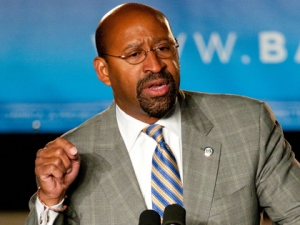The Resource of Time
Pioneers Lester Brown, David Suzuki, Jonathan Porritt and others say that we are in a race against time. We are living in a small window when we can still affect positive change, have the technology to deliver that change, and could see the benefits of action towards sustainability for the planet. Inaction poses the greatest security threat.
EPA Awards More Than $1 Million to College Teams for Innovative Environmental Solutions
 The U.S. Environmental Protection Agency (EPA) awarded more than $1 million in grants to 15 university and college teams from across the country who participated in the 8th Annual National Sustainable Design Expo on the National Mall in Washington, D.C. for their innovative environmental solutions. EPA’s People, Prosperity and the Planet (P3) award competition was held at the expo, and featured more than 300 college innovators showcasing their sustainable projects designed to protect the environment, encourage economic growth and use natural resources more efficiently. Some P3 team projects include a new process that uses spinach to capture and convert the sun’s energy to electricity and a partnership with a local landfill to design a process that uses waste heat and drainage to grow algae for biodiesel production.
The U.S. Environmental Protection Agency (EPA) awarded more than $1 million in grants to 15 university and college teams from across the country who participated in the 8th Annual National Sustainable Design Expo on the National Mall in Washington, D.C. for their innovative environmental solutions. EPA’s People, Prosperity and the Planet (P3) award competition was held at the expo, and featured more than 300 college innovators showcasing their sustainable projects designed to protect the environment, encourage economic growth and use natural resources more efficiently. Some P3 team projects include a new process that uses spinach to capture and convert the sun’s energy to electricity and a partnership with a local landfill to design a process that uses waste heat and drainage to grow algae for biodiesel production.
Following an initial peer review process, this year’s winners were selected from 45 competing teams after two days of judging by a panel of national experts convened to provide recommendations to the American Association for the Advancement of Science. EPA selected the award-winning projects from the most competitive pool of teams ever, basing their decisions on the potential to provide innovative, cutting-edge sustainable solutions to worldwide environmental problems.
“The competition and expo are not only about EPA’s prestigious P3 award, but also about supporting the next generation of this country’s innovators and entrepreneurs who are entering the environmental and public health field with passion to make a difference and many brilliant ideas,” said Lek Kadeli, acting assistant administrator for the EPA’s Office of Research and Development. “The P3 program gives these students the opportunity to bring those ideas to realization and many have the potential to make significant impacts on our nation’s sustainable future and development of environmental technologies.” The remaining article and winners list – EPA Awards More Than $1 Million to College Teams for Innovative Environmental Solutions
Reflections on Earth Day 2012 – by Al Gore
In 1994, I was asked by Rachel Carson’s publisher to write the introduction for the 30th anniversary edition of Silent Spring. It was, of course, a privilege and honor. Here is part of what I wrote:
“Writing about Silent Spring is a humbling experience for an elected official,because Rachel Carson’s landmark book offers undeniable proof that the power of an idea can be far greater than the power of politicians. In 1962, when Silent Spring was first published, “environment” was not even an entry in the vocabulary of public policy. In a few cities especially Los Angeles, smog had become a cause of concern, albeit more because of its appearance than because of its threat to public health. Conservation—the precursor of environmentalism — had been mentioned during the 1960 Democratic and Republican conventions, but only in passing and almost entirely in the context of national parks and natural resources. And except for a few scattered entries in largely inaccessible scientific journals, there was virtually no public dialogue about the growing, invisibly dangers of DDT and other pesticides and chemicals. Silent Spring came as a cry in the wilderness, a deeply felt, thoroughly researched, and brilliantly written argument that changed the course of history. Without this book, the environmental movement might have been long delayed or never have developed at all. Read the full article: Reflections on Earth Day April 21, 2012 – 9-57 AM
Carolyn Raffensperger is executive director of the Science and Environmental Health Network (SEHN). After a career as an archaeologist, she worked for the Sierra Club, addressing an array of environmental issues. Since 1994, with SEHN and as an environmental lawyer, she has specialized in the fundamental changes in law and policy necessary for the protection and restoration of public health and the environment.
EPA Wants Public to Know about Lead-Safe Renovation Requirements: Pertains to homes and other facilities built before 1978
 By VL Hudson – Got plans to renovate an old home? Convert an older structure – a dilapidated shed for example – into a child’s playhouse? Whether you do it yourself or engage the services of a licensed contractor, the US Environmental Protection Agency recommends knowing the facts about childhood lead poisoning, as well as the new EPA requirements for contractors working on structures built prior to 1978.
By VL Hudson – Got plans to renovate an old home? Convert an older structure – a dilapidated shed for example – into a child’s playhouse? Whether you do it yourself or engage the services of a licensed contractor, the US Environmental Protection Agency recommends knowing the facts about childhood lead poisoning, as well as the new EPA requirements for contractors working on structures built prior to 1978.
For decades lead poisoning has been one of the most critical environmental health threats to American children. Despite efforts to eradicate it, one million children still suffer from health effects related to lead-based dust. As part of efforts to permanently safeguard children and others against this risk, on April 22, 2008, the US EPA issued the Lead Renovation, Repair and Painting Rule.
The LRRP requires professionals involved in “projects that disturb lead-based paint in pre-1978 homes, child care facilities and schools be certified by EPA and that they use certified renovators who are trained by EPA-approved training providers to follow lead-safe work practices.” April 22, 2010 was the EPA deadline for renovation contractors to be trained in safe lead-handling and disposure procedures to obtain the new EPA lead-safe certification.
While the EPA reports success in promoting its lead-safe certification to contractors – 750,000 across the nation trained so far – getting the message across to the public has been problematic for several reasons. Finances and ignorance of the new requirement apparently the main two: EPA lead-safe certified contractors report losing bids to untrained contractors, EPA officials report.
Following up on massive outreach in 2010 and 2011 to contractors, states, counties, municipalities, childcare centers and other similar agencies, the EPA focus this year will be on school districts and the public at large. It will use billboards, PSAs and other media to let “people know lead-based paint is dangerous to kids, especially those below the age of 6,” Nancy Kain, Regional Lead Coordinator (Region 9 EPA San Francisco) says. “People need to hire someone who is certified by the EPA.”
Most important, Kain adds, all EPA lead-safe certified contractors are required to provide the lead hazard information pamphlet Renovate Right: Important Lead Hazard Information for Families, Child Care Providers, and Schools to homeowners, childcare center owners, occupants of childcare facilities and to parents and guardians of children under age six who attend childcare facilities built prior to 1978.
“Long-term, we hope to see the blood lead levels in children decrease,” Kain replies when asked about measurements of success. “We can’t see that yet, because it’s too soon. What’s really important is letting the public know the danger of disturbing lead-based paint in pre-1978 structures. They need to hire someone who is certified to protect themselves and their family.”
Source: Victoria Hudson Newsvine :
T.C. Chan Center to Host the United Nations Environment Programme – Sustainable Buildings and Climate Initiative’s 2011 Fall Symposium
International Building Industry Leaders to Promote Policies and Practices for Sustainability
 The T.C. Chan Center for Building Simulation and Energy Studies will host the United Nations Environment Programme-Sustainable Buildings and Climate Initiative (UNEP-SBCI) Fall Symposium, taking place on October 27th and 28th, 2011, at the University of Pennsylvania. Designed to promote sustainable and green building practices around the world, the two-day symposium will focus on “Promoting Policies and Practices for Sustainability.”
The T.C. Chan Center for Building Simulation and Energy Studies will host the United Nations Environment Programme-Sustainable Buildings and Climate Initiative (UNEP-SBCI) Fall Symposium, taking place on October 27th and 28th, 2011, at the University of Pennsylvania. Designed to promote sustainable and green building practices around the world, the two-day symposium will focus on “Promoting Policies and Practices for Sustainability.”
This week’s high-profile UNEP-SBCI event will bring leading experts from around the world to discuss and encourage implementing tools, technology and policies to create sustainable building practices on local and global scales. Esteemed speakers and panelists will include international leaders from multinational companies, research institutes, governments and non-profit organizations from countries such as Japan, Jordan, Portugal, Brazil, Canada and the U.S.
UNEP-SBCI event speakers and panelists include:
– Mayor Michael Nutter of Philadelphia
– David Miller, Former Chair of C40 & Former Mayor of the City of Toronto
– Michelle Moore, Federal Environment Executive, Council on Environmental Quality, Executive Office of the President
– Roger Platt, U.S. Green Building Council (USGBC)
– Marcus Lee, Urban Development — Cities and Climate Change Finance, Economics and Urban Development — The World Bank. Read On: T.C. Chan Center to Host the United Nations Environment Programme – Sustainable Buildings and Climate Initiative’s 2011 Fall Symposium
Kenya: Tribute to Heroine Wangari Maathai
Margareta Wa Gacheru
28 September 2011- Opinion: All Africa News: News of Wangari Maathai’s demise on Sunday, September 25th spread around the world like wildfire. What’s striking is that Wangari is one person who (for better or worse) got heaps of global media coverage in her lifetime, not only at her demise, which is rare.
Usually, one has to wait for someone’s obituary to find out all the incredible tidbits about their life. But not Wangari: she was a news maker whose charismatic leadership and controversial stands for noble causes, however popular or unpopular, made her front page news since the 1970s in Kenya and a headliner in international news most often in this new millennium.
This is not to say that Wangari sought the limelight. No! The woman simply sought justice and equity and the ‘best practices’ in all arenas, particularly in government-where she knew, for instance, that women deserved equal treatment to men, and jobless people were just as entitled to jobs as any other human being. Even the Greenbelt Movement grew out of Wangari’s sense of justice and the need to take care of the planet as well as the people who were suffering as a consequence of deforestation, poverty, and poor social policies that neglected the plight of the vast majority of the people.
Nobel Prize Winner Wangari Maathai
Wangari’s first commitment was to the Kenyan people, particularly to Kenyan rural women. This I discovered way back in the late 1970s when she was Chairperson of the National Council of Women of Kenya and head of the Environment Committee which would eventually become the Greenbelt Movement.
At the time of our meeting, Wangari’s commitment to social justice for both the people and the planet was palpable; which is why I came away from that first interview (I was working for Hilary Ng’weno’s Nairobi Times at the time) feeling this was a woman who could not only become the president of Kenya one day.
I felt as if she could become President of Africa; if such a position ever came into being she’d fill the bill perfectly. She had the vision, the conviction, the brilliant ideas and the burning passion to serve as an instrument for the good of her people. Back then, Wangari made it clear to me that leadership was not a task she took lightly. On the contrary, she had been taught by the nuns early on in her life that the blessings bestowed on her in the form of a good education and opportunities to excel were gifts she had to apply and use to advance the lives of others less fortunate than herself.
Her combination of sincerity, conviction and humility was awesome because at the time, she was already holding positions of authority and power-as head of the Veterinary Anatomy Department at University of Nairobi and as Chair of NCWK.
And yet, what was clear even then was that she had just begun to fulfill her immense leadership capacity. And even now, I contend that in spite of her becoming a world-acclaimed environmentalist as well as a grounded social activist and former Kenyan MP, Wangari had barely scratched the surface of all she could have achieved if she hadn’t been blocked so often by lesser beings who were either jealous, envious, intimidated or threatened by her honesty, intelligence and charismatic leadership and authority.
As it was Wangari achieved more in one short lifetime than most people can even contemplate: She founded one of the most important environmental movements in the world, and one that spotlighted the capacity of African rural women to problem-solve for the planet; she ran for Parliament and won (although she was sorely under-utilized by the Kibaki government); and she succeeded in battle against one civilian dictator who attempted to grab public land in the heart of Nairobi for his personal self-engrandisement.
Her Nobel Prize in 2004 was for her successfully showing the world the clear-cut connection between resource depletion (and extraction), poverty and war. She was honored for identifying how protecting the earth’s natural resources is an important peace-making strategy.
My one disappointment with Wangari is that in 1992 when the National Commission on the Status of Women called on her to run for the presidency, she declined. She noted that since she was from the same constituency as Mwai Kibaki, she didn’t want to split the vote. But what if she had run? What if she had won? I’m convinced she could have, and then where would we be today? We can say there is no point speculating on ‘what could have been’, but we can know and trust that Wangari’s spirit still reigns in our hearts and that her spirit is still with us.
Japan Energy Law To Cut Nukes, Boost Solar, Wind
 By Chisaki Watanabe and Sachiko Sakamaki – Aug 18, 2011
By Chisaki Watanabe and Sachiko Sakamaki – Aug 18, 2011
Japan’s lower house of parliament is set to pass legislation to subsidize renewable energy amid a push to reduce dependence on nuclear power, paving the way for Prime Minister Naoto Kan to quit as early as next week.
The bill requires utilities to buy electricity generated by geothermal, solar and wind sources at above-market rates in order to stimulate investment in renewable energy, which accounts for 9 percent of Japan’s power supply. Kan last month called for phasing out atomic power after the March earthquake and tsunami caused the worst nuclear disaster in 25 years.
Passage of the bill marks the last of three legislative goals Kan set down before fulfilling a pledge to resign. His popularity has dropped over his handling of the quake and the crippling of Tokyo Electric Power Co.’s Fukushima atomic power plant. An opposition politician yesterday said the lower house vote, originally scheduled for today, may be delayed.
Introducing the subsidies, known as feed-in tariffs, may help companies like Mitsubishi Heavy Industries Ltd. (7011), which makes wind turbines and develops geothermal plants, and solar panels makers Panasonic Corp. (6752) and Sharp Corp. Japan aims to increase the size of the renewable energy market to 10 trillion yen ($130 billion) by 2020, from about 1 trillion yen in 2009, the Ministry of Economy, Trade and Industry said in 2010. Read the full article – Bloomberg: Japan Energy Law To Cut Nukes, Boost Solar, Wind
Coal vs. Environment
 Soledad O’Brien Explores Both Sides of Mountaintop Removal
Soledad O’Brien Explores Both Sides of Mountaintop Removal
Battle for Blair Mountain: Working in America airs Sunday, August 14 at 8:00pm ET & PT on CNN/U.S.
Sharples, West Virginia – population: around 100 people – is ground zero in the fight over an issue of importance to every American who has ever plugged in a computer, watched a television or taken a hot shower. Around 50 percent of electrical power in the United States is produced by coal. Across the nation, a schism that separates pro-coal and pro-environment movements over mountaintop removal, a destructive yet highly effective form of strip mining, is deepening.
CNN documents the intense struggle over mountaintop removal in Battle for Blair Mountain: Working in America, debuting on Sunday, August 14 at 8:00pm ET and PT, with a replay on Saturday, August 20. Anchor and Special Correspondent Soledad O’Brien examines the fight over Spruce One, one of the largest mountaintop removal sites ever proposed in the U.S. When O’Brien’s team first arrived in Sharples, W.V., nearly everyone in Appalachia was waiting to see if the Environmental Protection Agency was going to allow Spruce One’s permit to proceed, citing Clean Water Act violations.
Several groups were invested in the fight: coal miners who wanted to keep the jobs they’ve had for decades, the green activists who oppose all coal mining and a coalition of people who would like to see mountaintop removal replaced by less damaging mining practices. Influential people such as EPA Administrator Lisa Jackson, Senator Joseph Manchin (D-WV) and Robert Kennedy, Jr. had plenty to say about the outcome, too. O’Brien and her team tell the story from all sides.
“I see what’s down here and what’s down here is still beautiful, still pretty, clean,” Linda Dials says confidently. “I don’t have any problems what so ever with the water or anything else,” says the miner’s wife.
Linda and her husband James Dials have deep roots in the coalfields of southern West Virginia. James works in mountaintop removal and is proud of his job reconstructing mountains. He blames this fight on outsiders who simply don’t understand a coal miner’s way of life. Like most miners today, James and Linda feel under attack. They see efforts by environmentalists and the EPA to limit mountaintop removal as a threat to coal mining jobs everywhere. Linda is passionate and dedicated to protecting her community and their coal. With her husband’s job on the line, she finds herself on the frontlines of the fight as a coal activist. Read on: Soledad O’Brien Explores Both Sides of Mountaintop Removal
The Environment


